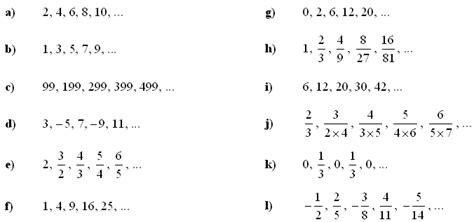In the vast realm of mathematics, calculus reigns as a formidable discipline, demanding both analytical prowess and an unwavering determination. Among its myriad branches, sequences stand as a testament to the intricate interplay of convergence, divergence, and limits. For those seeking to push their mathematical boundaries, the following sequence problems offer a formidable challenge, testing the limits of your understanding and pushing you to the pinnacle of your abilities.

Evaluating Complex Expressions
Problem 1: Determine the sum of the first 10 terms of the sequence defined by:
$$a_n = \frac{(-1)^n}{n} + \frac{1}{2n+1}$$
Problem 2: Find the value of the infinite sum:
$$\sum_{n=1}^\infty \frac{n^2+1}{n^3-1}$$
Problem 3: Evaluate the limit of the sequence:
$$a_n = \sqrt{n^2+1} – \sqrt{n^2-1}$$
Limits and Convergence Tests
Problem 4: Determine whether the sequence defined by:
$$a_n = \frac{2^n – 3^n}{2^n + 3^n}$$
is convergent or divergent. Use the ratio test.
Problem 5: Use the squeeze theorem to prove that the sequence:
$$a_n = \frac{\sin(n)}{n}$$
converges to zero.
Problem 6: Find all values of $x$ for which the following series converges:
$$\sum_{n=1}^\infty \frac{x^n}{(n+1)(n+2)}$$
Applications and Connections
Problem 7: A population of bacteria grows according to the sequence defined by:
$$a_n = 1000(2)^{n-1}$$
where $a_n$ represents the population at the end of the $n$th day. How many bacteria will there be at the end of the 10th day?
Problem 8: The velocity of a projectile launched vertically upwards is given by the sequence:
$$a_n = v_0 – gn$$
where $v_0$ is the initial velocity, $g$ is the acceleration due to gravity, and $n$ represents the number of seconds since launch. If the initial velocity is $100$ m/s and $g = 9.8$ m/s², find the total distance traveled by the projectile in the first 5 seconds.
Common Mistakes to Avoid
- Incorrectly applying convergence tests: Be sure to understand the assumptions and criteria for each test you use.
- Neglecting special cases: Always consider the cases where $n = 0$ or $x = 0$.
- Making algebraic errors: Pay close attention to the order of operations and algebraic manipulations.
- Ignoring convergence conditions: In series problems, verify that any conditions for convergence are satisfied before evaluating the sum.
Why It Matters
Tackling hard calculus sequence problems not only sharpens your mathematical skills but also offers invaluable benefits:
- Enhanced problem-solving abilities: Solving complex problems cultivates your analytical thinking and creativity.
- Improved logical reasoning: Sequencing problems require a systematic and logical approach to identify patterns and establish connections.
- Increased mathematical confidence: Overcoming challenging problems builds confidence and encourages you to tackle future mathematical endeavors with greater enthusiasm.
- Unlocking new applications: By understanding convergence and limits, you gain the ability to model and analyze a wide range of real-world phenomena, such as population growth, financial markets, and the motion of objects.
Conclusion
Hard calculus sequence problems serve as a crucible for your mathematical abilities, testing your understanding, pushing your limits, and preparing you for the rigors of advanced mathematics and its countless applications. By embracing the challenge and persevering through the complexities, you not only expand your mathematical prowess but also unlock the potential to solve real-world problems and make meaningful contributions to scientific and technological advancements.
Tables
Table 1: Convergence Tests for Sequences
| Test | Condition | Convergent if | Divergent if |
|---|---|---|---|
| Ratio Test | $\lim\limits_{n\to\infty} \left | \frac{a_{n+1}}{a_n} \right | < 1$ |
| Root Test | $\lim\limits_{n\to\infty} \sqrt[n]{ | a_n | } < 1$ |
| Squeeze Theorem | $b_n \le a_n \le c_n$ and $\lim\limits_{n\to\infty} b_n = \lim\limits_{n\to\infty} c_n = L$ | Yes | No |
Table 2: Applications of Calculus Sequences
| Application | Sequence | What it Models |
|---|---|---|
| Population Growth | $a_n = a_0 r^n$ | Exponential growth or decay |
| Financial Markets | $a_n = a_0(1+r)^n$ | Compound interest |
| Projectile Motion | $a_n = v_0 – gn$ | Vertical motion of an object |
Table 3: Common Mistakes in Sequence Problems
| Mistake | Description |
|---|---|
| Incorrect Convergence Test | Using an inappropriate test or applying it incorrectly |
| Neglected Special Cases | Failing to consider $n = 0$ or $x = 0$ |
| Algebraic Errors | Simplifying expressions incorrectly |
| Ignored Convergence Conditions | Assuming convergence without verifying conditions |
Table 4: Benefits of Solving Hard Sequence Problems
| Benefit | Explanation |
|---|---|
| Enhanced Problem-Solving Abilities | Develops analytical thinking and creativity |
| Improved Logical Reasoning | Requires a systematic and logical approach |
| Increased Mathematical Confidence | Builds self-assurance and encourages perseverance |
| Unlocked New Applications | Provides a foundation for modeling and analyzing real-world phenomena |
